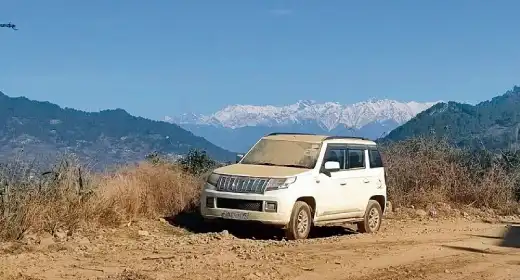Dusty Road Between Mandi and Kotli: A Health Hazard for Commuters

The dusty road connecting Mandi and Kotli has raised serious health concerns among local commuters and residents. As one of the major routes linking these two areas, the road’s condition has become a significant issue. The fine dust particles stirred up by traffic not only impair visibility but also pose severe health risks to those who frequently travel this route. In this article, we will explore how this dust affects public health and what measures can help alleviate the problem.
Health Risks of Dust Exposure
The dust on the road between Mandi and Kotli consists primarily of fine particulate matter (PM), which people can easily inhale into their lungs. Health experts warn that exposure to such fine dust particles can lead to various respiratory problems, including asthma, bronchitis, and other chronic lung diseases. People with pre-existing health conditions face a higher risk, as the dust exacerbates symptoms and can trigger attacks.
A Growing Concern for Commuters
Commuters traveling between Mandi and Kotli suffer the most from the dusty conditions. Whether traveling by car, bus, or motorcycle, the fine dust particles easily enter vehicles, causing discomfort and health risks. Motorcyclists are especially vulnerable, as they face direct exposure to the dust without any protective barriers.
Many commuters report feeling uncomfortable during their travels, with some experiencing coughing and shortness of breath after crossing the dusty stretch of the road. The long-term effects of this exposure remain a growing concern for local residents who rely on this road for daily commuting.
Environmental Impact of Dust
In addition to health risks, the excessive dust on the road harms the surrounding environment. The dust settles on vegetation, reducing soil quality and affecting plant life. This damage negatively impacts local agriculture, which plays a significant role in the region’s economy.
Furthermore, the fine dust particles contribute to air pollution, causing broader environmental issues. This pollution can harm ecosystems and contribute to climate change, making it an urgent problem for local authorities to address.
Efforts to Address the Issue
Local authorities and environmental organizations understand the health risks caused by the dusty road between Mandi and Kotli. Several initiatives have aimed to mitigate the problem and improve air quality in the area. These solutions include using water sprinklers to dampen the dust, constructing paved roads, and installing barriers to reduce dust emissions from vehicles.
Short-Term Solutions: Water Sprinklers and Dust Suppression
In 2023, the local government implemented an initiative where they sprayed water on the road during peak traffic hours. This temporarily reduced dust particles but failed to provide a long-term solution. Environmental experts suggest that long-term measures, such as proper road maintenance and the introduction of green zones, could control dust pollution more effectively.
The Need for Long-Term Road Improvements
Paving the dusty sections of the road with durable, dust-resistant materials could significantly reduce dust emissions. Long-term investments in road infrastructure and dust control measures will be critical in addressing this ongoing issue.
Community Involvement in Addressing the Problem
The local community has also raised concerns and called for better infrastructure and health safety measures. Local health officials have been working closely with residents to raise awareness about the risks of dust pollution. Discussions have also taken place about distributing face masks to commuters and organizing health camps for those affected by respiratory problems.
Residents have petitioned for improved road conditions, including paving the dusty stretches of the road. This change could drastically reduce dust emissions and improve air quality. With the combined efforts of the local authorities and the community, there is hope that this issue will be resolved.
What Commuters Can Do to Protect Themselves
While waiting for long-term solutions, commuters can take several steps to protect themselves from the harmful effects of dust exposure. Wearing a mask, especially during peak hours when dust levels are high, helps minimize inhalation of dust particles. Additionally, keeping car windows closed during the journey can prevent dust from entering the vehicle.
Protective Measures for Motorcyclists
Motorcyclists should consider wearing protective face masks and goggles to reduce their exposure. Carrying a bottle of water to stay hydrated is also advisable, as the dry air and dust can cause dehydration.
General Safety Tips for Commuters
For car and bus passengers, using air conditioning with air filters can help reduce dust exposure. Commuters should also avoid traveling during peak dust hours whenever possible.
Government’s Role in Tackling the Issue
The government plays a crucial role in reducing dust pollution on the road between Mandi and Kotli. Through proper infrastructure investment, authorities can help reduce dust emissions and ensure safer travel for commuters. Additionally, they can implement stricter regulations on vehicle emissions to reduce dust created by heavy traffic.
Potential Solutions: Green Zones and Tree Plantations
Developing green zones or tree plantations along the roadside could help trap dust particles and improve air quality. The government could also consider using eco-friendly materials for road construction to minimize dust generation.
Conclusion
The dusty road between Mandi and Kotli presents a significant health risk to commuters and local residents. Exposure to dust particles can lead to serious respiratory issues and environmental damage. While temporary measures have been implemented, the region still needs more long-term solutions to reduce the health hazards associated with this road. Government action, alongside community involvement, will be essential to resolve this issue.
For further information on air pollution and its health risks, you can visit this health resource.






